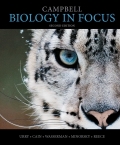
Concept explainers
To explain:
The origin of the eukaryotic photosynthesis if the photosynthetic organelle of a protist is discovered to be most closely related to a different cyanobacterium than the one that gave rise to plastids.
Introduction:
Endosymbiosis is a hypothesis that explains the evolution of the eukaryotic cells like mitochondria in animal and fungi and chloroplast in plants from the prokaryotes. The mitochondria and chloroplast show similarities to the bacterial cells. The eukaryotes are called as “combination” organisms because their DNA shows that some of their cellular character and genes are derived from archaebacteria and some other bacteria. This occurred due to a symbiotic relationship process known as endosymbiosis. In this association, one organism lives inside the other.
Want to see the full answer?
Check out a sample textbook solution
Chapter 25 Solutions
Campbell Biology In Focus
- Endosymbioses that lead to the evolution of euglenoids and, separately, the evolution of chlorarachniophytes were the result of the combining of: a. two ancestral nonphotosynthetic prokaryotes. b. two ancestral photosynthetic prokaryotes. c. a nonphotosynthetic eukaryote with a photosyntheticeukaryote. d. a photosynthetic prokaryote with a nonphotosyntheticeukaryote. e. mitochondria with an already established plastid.arrow_forwardWHAT IF? A classmate proposes that mitochondria andchloroplasts should be classified in the endomembranesystem. Argue against the proposal.arrow_forwardWhat types of biological abilities can be combined to create more capable, more complex cells? How does the presecence of different types of ribosomes inside a eukaryotic cell strengthen the endosymbiotic theory? How does chloroplasts and mitochondria found within a cell have two membranes? How does the emergence of endosymbotic theory change the way humans view microorganisms? Will people be comfortable imaginning that the life functions of pants and animals, including their own, are actually dependent on the coexistence of many different microscopic pieces?arrow_forward
- Evidence indicating the chloroplasts were originally free-living prokaryotes that subsequently evolved a symbiotic relationship with a eukaryotic host includes all of the following except: Ability of chloroplasts to synthesize all their own proteins Presence of circular DNA in chloroplasts and in free-living prokaryotes Similarities of rRNA sequences between chloroplasts and free-living prokaryotes Similarities of structures between chloroplasts and some contemporary free-living prokaryotes Carrow_forwardIn primary endosymbiosis, a nonphotosynthetic eukaryotic cell engulfed a photosynthetic cyanobacterium. How many membranes surround the chloroplast that evolved?arrow_forwardWhy is the mitochondria so important to a eukaryoWhich is an example of a prokaryotic cell?tic cell? What is the plasmid in prokaryotes? What is the jelly-like matrix in both prokaryotes and eukaryotes that provides form to the cell and holds many of the organelles? What attribute should a hypothesis contain so that it lends itself to an objective experiment that relies on quantitative observations and data? Which is a properly written hypothesis?Which hypothesis states that no statistical significance exists between the independent and dependent variable? Question options: statistical hypothesis complex hypothesis null hypothesis alternative hypothesis simple hypothesisarrow_forward
- . Which of the following prokaryotic kingdoms is characterized by the absence of a nucleus, the absence of histone proteins, the presence of fatty acids ester-linked to glycerol in their G-3-P cell membrane, and the presence of enzymes for constructing a peptidoglycan cell wall? kingdom Archaeobacteria kingdom Animalia kingdom Fungi kingdom Plantae kingdom Eubacteriaarrow_forwardEvolution of what biological process is hypothesized to have been made possible by the appearance of chlorophyll in the mesozones of a prokaryote cell? A) self-replicating molecules B) multi-cellularity C) glycolysis D) photosynthesis E) none of these.arrow_forward1. Why was the great oxygenation event important for mitochondrial development? a) In your own words, define symbiotic. 2. Chloroplasts and mitochondria both contain a circular DNA chromosome, and ribosomes. Why does this evidence support the theory of endosymbiosis as the mechanism for the origin of eukaryotic cells? a) Today, could mitochondria live independently of their eukaryotic cell host? Give two pieces of evidence to support your answer.arrow_forward
- WHAT IF? How might a sudden and dramatic change inyour diet affect the diversity of prokaryotic species thatlive in your digestive tract?arrow_forwardQ1: What are the products of cellular respiration? Q2: Considering the inputs and products of each process, why is cellular respiration considered the reciprocal process to photosynthesis? Q3: Which of the three stages of cellular respiration—glycolysis, the Krebs cycle, or oxidative phosphorylation—could organisms have used 4 billion years ago, before photosynthesis by cyanobacteria released oxygen into the atmosphere?arrow_forwardich statement best explains why a third domain, Archaea, was added to the original two domains of Bacteria and Eukarya Scientists discovered that eukaryotes are unicellular. Scientists discovered that eukaryotes have cell walls. Scientists discovered that some prokaryotes have cell walls. Scientists discovered that some prokaryotes live in extreme environments. Pause https://olapalmbea ch performancematters.com/ola/ola jsp?dientCode-fiPalmBeach# DELL escarrow_forward
 Biology Today and Tomorrow without Physiology (Mi...BiologyISBN:9781305117396Author:Cecie Starr, Christine Evers, Lisa StarrPublisher:Cengage Learning
Biology Today and Tomorrow without Physiology (Mi...BiologyISBN:9781305117396Author:Cecie Starr, Christine Evers, Lisa StarrPublisher:Cengage Learning Biology: The Dynamic Science (MindTap Course List)BiologyISBN:9781305389892Author:Peter J. Russell, Paul E. Hertz, Beverly McMillanPublisher:Cengage Learning
Biology: The Dynamic Science (MindTap Course List)BiologyISBN:9781305389892Author:Peter J. Russell, Paul E. Hertz, Beverly McMillanPublisher:Cengage Learning Biology 2eBiologyISBN:9781947172517Author:Matthew Douglas, Jung Choi, Mary Ann ClarkPublisher:OpenStax
Biology 2eBiologyISBN:9781947172517Author:Matthew Douglas, Jung Choi, Mary Ann ClarkPublisher:OpenStax


